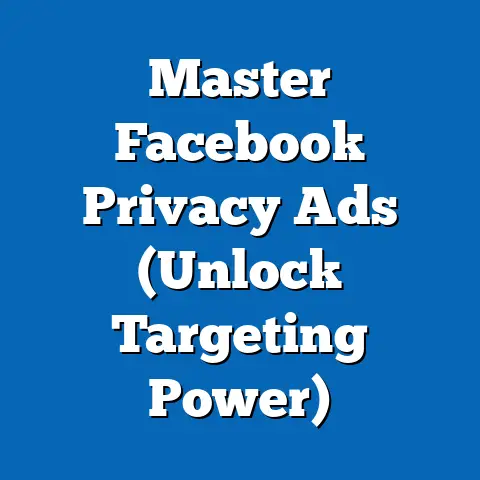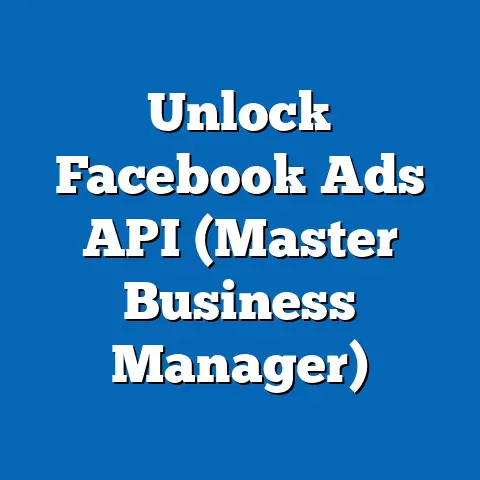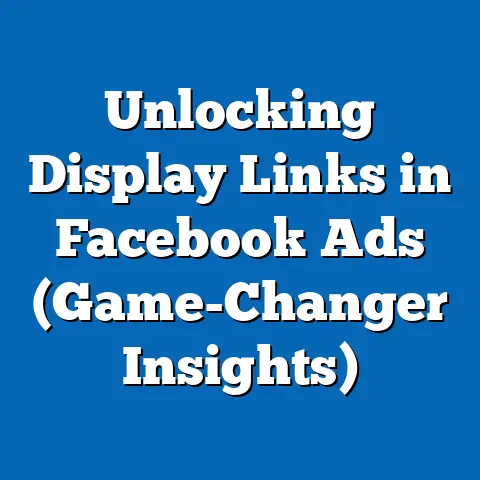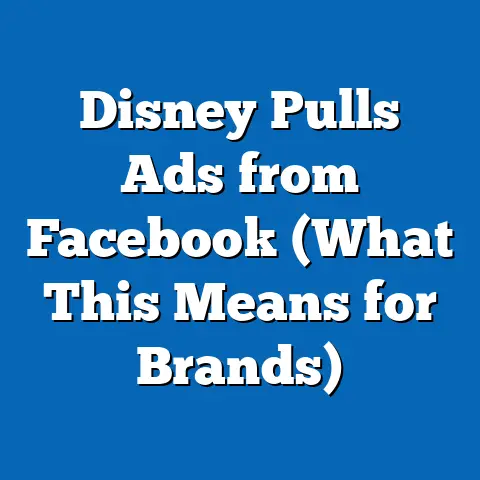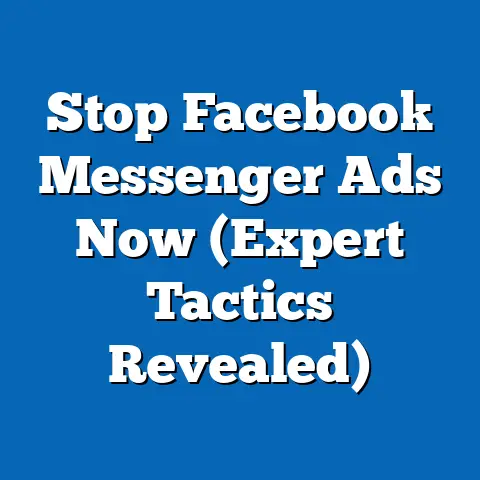Mastering Facebook Ads Opt-Outs (Unlocking Hidden Strategies)
Did you know that nearly 30% of users actively opt out of Facebook ads? It’s a figure that should make any advertiser sit up and take notice. Yet, in my experience, many advertisers are oblivious to the hidden strategies that can turn this challenge into an opportunity. I’ve seen firsthand how understanding and addressing ad opt-outs can significantly improve campaign performance and ROI. Let’s dive into the world of Facebook ad opt-outs and discover how you can not just mitigate their impact, but actually leverage them to your advantage.
Understanding Facebook Ads Opt-Outs
In the context of Facebook advertising, an opt-out is when a user actively chooses to stop seeing ads from a specific business, or to limit the types of ads they see based on their interests and data. This can happen in several ways: a user can click “Hide Ad,” adjust their ad preferences in their Facebook settings, or even use third-party browser extensions designed to block ads altogether.
Opt-outs are significant for advertisers because they directly impact ad reach, frequency, and overall performance. When users opt out, they are essentially removing themselves from your potential audience, which can lead to decreased impressions, lower click-through rates (CTR), and potentially higher costs per acquisition (CPA). It’s like trying to sell ice cream in Antarctica – your target market isn’t receptive to your message.
Recent statistics highlight the growing concern around ad personalization and privacy. According to a 2023 study by Pew Research Center, approximately 72% of Americans believe that most of what they do online and while using apps is being tracked by advertisers and tech companies. This heightened awareness contributes to the increasing trend of users taking control of their data and ad preferences. In my own experience, I’ve seen campaigns targeting privacy-conscious demographics experience significantly higher opt-out rates than those targeting other groups.
Takeaway: Understanding what Facebook ad opt-outs are and their impact on your campaigns is the first step in developing effective strategies to mitigate their effects. Stay informed about the latest user privacy trends and statistics to better anticipate and address these challenges.
The Psychology Behind Opt-Out Decisions
Why do users choose to opt out of ads? The reasons are multifaceted and often rooted in psychological factors. Understanding these drivers is crucial for crafting ad campaigns that resonate with your target audience and minimize the likelihood of opt-outs.
One of the primary reasons is privacy concerns. In an era of data breaches and surveillance capitalism, users are increasingly wary of how their personal information is being collected and used by advertisers. They may feel uncomfortable with the level of personalization in ads, perceiving it as intrusive or even creepy. I remember running a campaign where we used hyper-personalized messaging based on user interests, and while some responded positively, others expressed concern about how we knew so much about them.
Ad fatigue is another significant factor. Users are bombarded with ads every day, and over time, they can become desensitized or even annoyed by the constant stream of promotional messages. This is especially true if the ads are irrelevant, repetitive, or poorly executed. Think about it: how many times have you seen the same ad pop up in your feed, even after you’ve already made a purchase?
Another contributing factor is poor ad experience. This includes ads that are irrelevant to the user’s interests, ads that interrupt their browsing experience, or ads that are simply annoying or offensive. Nobody wants to be interrupted by a loud, flashing banner ad when they’re trying to scroll through their newsfeed.
The psychology behind these decisions is closely linked to user experience on social media. Users want to feel in control of their online environment and to have a positive, engaging experience. When ads disrupt this experience, they are more likely to be rejected. Understanding your target audience’s mindset is paramount. What are their values? What are their pain points? What kind of content do they find engaging? By answering these questions, you can create ad campaigns that are not only relevant but also respectful of their privacy and preferences.
Takeaway: Understanding the psychological drivers behind opt-out decisions allows you to create more empathetic and effective ad campaigns. By addressing privacy concerns, avoiding ad fatigue, and providing a positive ad experience, you can reduce the likelihood of users opting out.
Identifying Opt-Out Trends
To effectively address Facebook ad opt-outs, it’s essential to identify and track the trends that influence them. This involves understanding the demographics most likely to opt out, as well as seasonal or situational factors that may impact opt-out rates.
Certain demographics are more likely to opt out of ads than others. For example, younger users (Gen Z and Millennials) tend to be more privacy-conscious and tech-savvy, making them more likely to use ad blockers or adjust their ad preferences. Older users may be less familiar with these tools but may still opt out if they find ads irrelevant or intrusive.
In my experience, users with a strong interest in privacy-related topics, such as cybersecurity or digital rights, are also more likely to opt out of ads. These individuals are often more informed about data collection practices and more proactive in protecting their personal information.
Seasonal or situational trends can also influence opt-out rates. For example, during major global events or economic downturns, users may become more sensitive to advertising and more likely to opt out. I remember seeing a spike in opt-out rates during the peak of the COVID-19 pandemic, as users became more focused on essential information and less receptive to promotional messages.
To track these trends effectively, advertisers can use a variety of tools and methods. Facebook Ads Manager provides some basic data on ad performance, including opt-out rates. However, for more granular insights, you may need to use third-party analytics tools or conduct your own surveys and user research.
Takeaway: Identifying opt-out trends is crucial for developing targeted strategies to reduce them. By understanding the demographics and situations that influence opt-out decisions, you can tailor your ad campaigns to better resonate with your target audience.
Unlocking Hidden Strategies to Reduce Opt-Outs
Now that we’ve explored the reasons behind opt-out decisions and how to identify trends, let’s dive into the practical strategies you can use to reduce them. These strategies focus on creating more relevant, engaging, and respectful ad experiences for your target audience.
Segmenting Your Audience
One of the most effective ways to reduce opt-outs is to segment your audience based on their preferences and behaviors. This allows you to create more tailored ad experiences that are relevant to their individual needs and interests.
Instead of targeting a broad audience with generic ads, try segmenting your audience based on factors such as age, gender, location, interests, and past purchase behavior. For example, if you’re selling fitness products, you could segment your audience into groups based on their preferred workout styles (e.g., yoga, weightlifting, running) and create ads that highlight the benefits of your products for each specific activity.
Enhancing Ad Relevance
Improving ad relevance is another critical strategy for reducing opt-outs. This involves crafting creative content, personalized messaging, and utilizing dynamic ads to ensure that your ads are as relevant as possible to each individual user.
Focus on creating ads that speak directly to your target audience’s pain points and offer solutions to their problems. Use compelling visuals and persuasive copy to capture their attention and communicate the value of your products or services.
A/B Testing and Optimization
Regular A/B testing is essential for identifying the types of ads that resonate best with your audience and reducing opt-out rates. By testing different ad formats, headlines, visuals, and calls to action, you can learn what works best and optimize your campaigns accordingly.
For example, you could test two different versions of an ad: one with a humorous headline and one with a more serious headline. By tracking the opt-out rates for each version, you can determine which approach is more effective at engaging your target audience.
Engagement and Retargeting
Even if a user has opted out of your ads, there are still ways to engage with them and potentially win them back. Re-engagement campaigns and retargeting ads can be effective strategies for reaching users who have previously opted out, but it’s important to approach these campaigns with sensitivity and respect.
Focus on providing value rather than simply trying to sell them something. Offer exclusive discounts, share helpful content, or invite them to participate in a contest or giveaway. The goal is to re-establish a connection with them and demonstrate that you understand their preferences.
Transparency and Trust
Building trust with users is paramount for mitigating opt-out decisions. Be transparent about how you collect and use their data, and give them control over their ad preferences.
Include clear and concise privacy policies on your website and in your ads. Explain how you use their data to personalize their ad experience, and assure them that you are committed to protecting their privacy.
Takeaway: By implementing these strategies, you can significantly reduce the likelihood of users opting out of your Facebook ads. Focus on creating relevant, engaging, and respectful ad experiences that resonate with your target audience.
Case Studies of Successful Facebook Ad Campaigns
To illustrate the effectiveness of these strategies, let’s examine a few real-world examples of brands that have successfully navigated opt-outs and improved their ad performance.
Case Study 1: A Sustainable Clothing Brand
A sustainable clothing brand noticed a high opt-out rate among environmentally conscious consumers. They responded by creating a series of ads that highlighted their eco-friendly manufacturing processes and commitment to ethical labor practices. They also partnered with environmental influencers to promote their brand and build trust with their target audience. As a result, they saw a significant decrease in opt-out rates and an increase in sales among environmentally conscious consumers.
Case Study 2: A Subscription Box Service
A subscription box service was struggling with ad fatigue among their target audience. They addressed this issue by diversifying their ad creative and using dynamic ads to personalize the ad experience for each user. They also implemented a retargeting campaign that offered exclusive discounts to users who had previously opted out of their ads. This strategy helped them re-engage with their target audience and reduce ad fatigue.
Case Study 3: A Local Restaurant
A local restaurant was facing challenges with ad relevance. They decided to segment their audience based on their location and interests and create ads that highlighted their daily specials and local events. They also implemented a loyalty program that rewarded customers for engaging with their ads. This approach helped them improve ad relevance and build stronger relationships with their local community.
Takeaway: These case studies demonstrate that by understanding the reasons behind opt-out decisions and implementing targeted strategies, you can significantly improve your Facebook ad performance.
Future Trends in Facebook Ad Opt-Outs
The future of Facebook ads and user privacy is constantly evolving. Based on current trends and updates from Facebook regarding ad policies, we can speculate on potential changes in user behavior and how advertisers can stay ahead of the curve.
One potential trend is the increasing use of artificial intelligence (AI) in ad targeting and personalization. AI can help advertisers create more relevant and engaging ads, but it also raises concerns about data privacy and transparency. Advertisers will need to be mindful of these concerns and ensure that they are using AI in a responsible and ethical manner.
Another trend is the growing demand for greater control over ad preferences. Users want to have more say in the types of ads they see and how their data is being used. Facebook is likely to respond to this demand by providing users with more granular control over their ad settings.
Takeaway: To stay ahead of the curve, advertisers need to be proactive in addressing user privacy concerns and adapting to changing trends. By embracing transparency, providing users with more control over their ad preferences, and using AI responsibly, you can build trust with your target audience and maintain a positive ad experience.
Conclusion
Facebook ad opt-outs present a challenge for advertisers, but they also offer an opportunity to innovate and create more engaging and relevant ad experiences. By understanding the reasons behind opt-out decisions, identifying trends, and implementing targeted strategies, you can significantly reduce opt-out rates and improve your ad performance.
Remember, the key is to focus on creating ads that are relevant, engaging, and respectful of user privacy. By doing so, you can build trust with your target audience and maintain a positive ad experience. I encourage you to apply the strategies outlined in this article to enhance your Facebook ad campaigns and maintain engagement with your target audience. The future of Facebook advertising lies in creating a more personalized, transparent, and user-centric experience. Embrace this challenge, and you’ll be well-positioned to succeed in the ever-evolving world of social media advertising.

